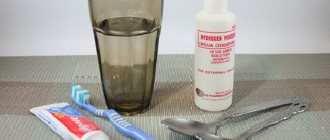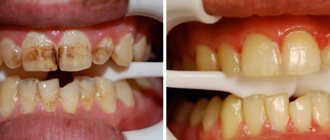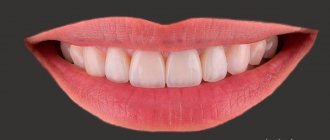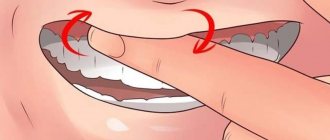Chewing teeth include premolars and molars. They are located at the end of the dentition, have a bumpy surface and take on the main load in the process of chewing food. Dentists note that these teeth are susceptible to caries. This is due to their complex structure and inaccessibility during cleaning.
Are your chewing teeth decayed? See your dentist to prevent further loss. A specialist will examine the oral cavity and tell you whether the teeth can be restored. Today, even severely damaged teeth are restored. If molars cannot be restored, they can be removed and implants placed.
What teeth can be restored?
In dental practice, it is customary to consider those crowns that are missing more than 50% of their parts as a result of:
- carious lesion;
- mechanical injury;
- the presence of old fillings that do not collapse on their own, but caries develops underneath them;
- depulpation, against which the crown becomes fragile and changes color;
- increased abrasion of dentin, etc.
If you do not seek help from a dentist in time, restoring the unit will be problematic.
Why does tooth loss occur?
Until the 18th century, there was a theory in the world about a worm that ate teeth, destroying them and causing pain. Scientists in Germany, India, China and Egypt seriously claimed that they saw them with their own eyes1. Despite all the naivety of the ancient terminology, this is partly true, because caries is actually caused by living microorganisms, but not worms, but streptococcal bacteria.
Tooth loss occurs as a result of various situations. Conventionally, the reasons can be divided into several groups:
- dental problems: this category includes all diseases that occur in the oral cavity. These are caries, pulpitis, cysts and granulomas, gum inflammation, gingivitis and periodontitis. Any of these problems can be quite easily solved if you consult a doctor in a timely manner. Otherwise, you can lose a once living and healthy tooth,
- chronic diseases of the body: diabetes leads to the destruction of enamel and affects the health of teeth in general, disrupting the metabolism in the body. Osteoporosis is also dangerous for their condition - the disease literally sucks all the calcium from the bones and dental tissues, causing teeth to crumble and fall out,
- natural aging of the body: the older a person is, the greater the likelihood of tooth loss, because with age many health problems appear,
- lifestyle: the presence or absence of bad habits is of great importance. For example, according to statistics, among those who lose teeth in middle age, about 30% are smokers. Participation in dangerous sports that lead to jaw injuries also leaves its mark: football, hockey, boxing. Due to poor oral hygiene and poor nutrition, patients are also forced to seek help from a dentist sooner or later.
Studies have shown that women are more afraid of dental treatment than men. According to statistics, only 45% of the stronger sex are afraid of dental procedures, while 65% of women surveyed are afraid of visiting the dentist2.
What are the dangers of losing teeth?
The peculiar concepts of beauty that existed among our ancestors were noticeably different from those of today. And problems of an aesthetic nature bothered people much less than in our days. However, it should be understood that in addition to the deterioration of external aesthetics, the loss of any number of teeth threatens with other problems:
- indigestion: the quality of chewing food deteriorates, which leads to the development of diseases of the gastrointestinal tract,
- change in bite: displacement, curvature, loosening of healthy teeth occurs, gaps appear in the row,
- violation of the position of antagonists: normally, each tooth has support - lateral and vertical. Due to the hole that has appeared on the opposite jaw, the tooth loses support and will gradually fall out of the hole,
- atrophy and thinning of bone tissue due to lack of chewing load,
- deterioration of articulation and diction: lisp, “swallowing” of some sounds,
- changes in the oval of the face: nasolabial folds worsen, the number of wrinkles increases, cheeks and lips recede - due to the absence of teeth (especially a large number), a person looks noticeably older,
- psychological discomfort: dental problems lead to isolation in communication, the appearance of complexes and decreased self-esteem.
Is it possible to restore a damaged tooth?
Yes, you can. But everything will depend on the volume of the lost coronal part and the general condition of the oral cavity.
For restoration, modern dentists use the following two main methods:
- installation of pins (reinforcement) made of fiberglass or titanium;
- introduction of so-called stump inlays.
If more than 50% of the unit is destroyed, and the dentist has doubts that the crown restored with a stump or pin will not withstand the chewing load, a metal-ceramic crown is installed on the stump pin inlay. When restoring teeth, it is mandatory to clean and fill the canals to avoid the development of caries.
Causes of tooth decay
Molars and premolars are large and strong teeth that can withstand significant loads. As a rule, they suffer not from high blood pressure and mechanical damage, but from insufficient oral hygiene. Small particles of food accumulate in the grooves and pits on the chewing surface, which are a favorable environment for the growth of bacteria. If you neglect to brush your teeth, caries develops, which destroys hard tissue.
The risk of destruction of chewing teeth increases:
- bruxism,
- malocclusion,
- unbalanced diet,
- habits of gnawing nuts and biting hands,
- drinking hot food with cold drinks,
- genetic predisposition,
- deficiency of calcium, phosphorus and vitamin D in the body.
Light filling on a pin – what are the advantages of the method?
A post filling is considered a reliable replacement material when a dentist is restoring a fractured unit. A titanium or fiberglass pin is inserted into the root canal, after which the coronal part is restored with a composite material. Among the disadvantages of the method is the potential risk of root fracture, since the pin fails under pressure, as well as shrinkage of the filling and the development of secondary caries under it.
Unfortunately, teeth restored in this way do not last forever. After 3–5 years, the dentist will have to change the filling or, due to global destruction of the crown, perform prosthetics/implantation.
Which prosthesis to put if the tooth root is removed - we consider all the options and choose the best one
Article navigation
- Indications for removal along with the root
- Prosthetic methods
- Removable dentures
- - for single defects
- - there are not many teeth
- - with complete edentia
- Fixed dentures supported by your teeth
- Supported by implants
- — restoration of 1-2 teeth
- - from 3 missing teeth in a row
- - full recovery
- Which way is better?
Question for a specialist
Many people, for one reason or another, lose teeth - one or several at once, or all, but gradually. This is often caused by injuries, aggressive caries, general diseases of the body, and even the fear of going to the dentist for treatment. But it is necessary to have prosthetics, otherwise problems with the gastrointestinal tract will begin, early wrinkles will appear, not to mention the unaesthetic appearance of the smile. Next, we will tell you what methods are used for prosthetics of teeth without roots - and which option is considered optimal.
How to restore a damaged tooth?
Treatment of a damaged tooth involves the following steps:
- examination by a dentist and assessment of further “future” damaged teeth;
- restoration of the stump area using a pin or inlay. The dentist treats the canals, strengthens the unit from the inside, thereby providing reliable support for the filling;
- The crown is built up using a composite material. If the work is done efficiently, the tooth can be visually almost indistinguishable from a natural one. The dentist repeats the shape, color and even transparency.
Treatment methods
The very first thing to do is to clean the canals - in the absence of a crown, carious inflammation can very quickly spread to a nearby nerve. After this, it is necessary to begin restoring the coronal part, i.e. the very top of the tooth. There are several best options for this.
Installation of a stump inlay A stump inlay is a modern alternative to pin-based extensions. A pin is simply a metal rod, while an inlay is created individually and accurately replicates the structure of the root system of a particular tooth. The result is a longer service life of both crown and root, as well as superior esthetics.
Price:
from 5,000 rubles more details about the solution
Installing a crown If the crown is destroyed to the level of the gingival margin, it is impossible to install only a filling - you need to think about prosthetic crowns. But such prostheses need support; the best option is to install a stump tab, which will strengthen the root system and create support for the prosthesis. Ceramic crowns are better suited for the front teeth, and metal-ceramic crowns for the side teeth. In both cases, an excellent solution would be zirconium dioxide prostheses - strong, aesthetic and very durable.
Price:
from 11,000 rubles more about the solution
Dental implantation This method is advisable to use when saving a tooth is not possible. And it is best to install the implant immediately after root removal. Thus, the preservation of bone tissue and its protection from rapid atrophy will be ensured. In some situations, especially when it comes to prosthetics of the front teeth, a crown can be placed on the implant immediately, which will restore the aesthetics of the row.
Price:
from 35,000 rubles more about the solution
How to properly care for restored crowns?
The tooth that was restored by a specialist is no longer as reliable as a healthy one. The attitude towards him should be as gentle and careful as possible. Avoid biting hard foods; do not “test” the composite’s strength by eating dry bread or nuts. If you have restored incisors, avoid biting into hard fruits and vegetables. And remember that the fillings will have to be renewed after a few years.
Doctors at Zuub.rf perform effective restoration of damaged teeth in the smile area, as well as chewing teeth, etc. Experienced specialists will conduct an examination, prepare the crown for further restoration and guarantee the reliability and strength of the “new” tooth, which will not differ from the rest. Sign up for a consultation right now!
If you have the symptoms described in this article, be sure to make an appointment at our clinic.
Don't self-medicate! Even the smallest problem, if not treated correctly, can significantly complicate your life.
By contacting us, you can be sure that:
- Get high-quality and free consultation .
- You will receive the best prices for treatment and the opportunity to receive a special promotional price.
- Only modern equipment and materials will be used.
- You will be treated by professional doctors with many years of experience.
- We offer treatment on credit or in installments. There is also the possibility of obtaining a tax deduction.
- We work seven days a week and without a lunch break, from 9 a.m. to 10 p.m.
+7 (495) 132-02-96
Make an appointment
How to prevent trouble
It is much easier to prevent this situation than to solve it. Preventive measures are extremely simple. Just follow a few important tips:
- Make it a rule to go to the dentist every six months for preventive examinations.
- At least once a year you should get rid of tartar and accumulated plaque (this is done in the dentist’s office).
- Hygienic measures must be carried out efficiently and regularly (at least twice a day).
- Nutrition should be complete and varied so that the body does not experience a deficiency of beneficial microelements.
- Try to drink only filtered water.
- Stop smoking as soon as possible.
- Carry out dental treatment in a timely manner.
Removable prosthetics
If there is no tooth, what can be supplied from budget options? This is where removable prosthetics comes to the rescue. It is also relevant if there are contraindications to prosthetics using crowns and implantation.
Butterfly prosthesis
Such a denture is relevant in the absence of one or maximum two teeth in a row. It consists of an artificial gum and crowns sewn into it. The design also has hooks to secure the removable denture on healthy teeth.
It is not possible to say that the “butterfly” can fully fill the gap in chewing function, so doctors recommend using the design only as a temporary measure.
Clasp dentures
If more than 1 or 2 teeth are “missing”, then the recommendations of orthopedists are clasp dentures. They can be attached to healthy teeth using clasp hooks, telescopic crowns or attachments.
You can also choose acrylic or nylon dentures as a solution. The latter are the most comfortable to wear, but are subject to stretching. Also, the nylon version cannot be “fixed” - after some time you will simply have to order a new one. Popular models – Acry-free and Quattro Ti
Signs of tooth decay under the crown
The first thing the owner of a crown notices is bad breath. Brushing, rinsing, and flossing do not help eliminate it, or give short-term results. Manifestations other than odor:
- Mobility of the crown or tooth.
- Darkening of the visible part.
- Recession of the gums, exposure of the cervical area.
- Unpleasant, purulent taste in the mouth.
- Discharge of pus.
- Redness of the gums.
Permanent bridge
Photo: bridge prostheses
Pros
- relatively low cost
- durability
- reliable fixation
Minuses
- teeth grinding required
- the supporting teeth under the crowns are destroyed
- the jawbone shrinks in volume
A bridge or dental bridge is a structure consisting of several crowns. The central one serves to replace the removed tooth, the others are used as a support. As a rule, the bridge is fixed on your own teeth, which are ground down quite heavily to cover it with a crown. This is one of the most important disadvantages of bridge prosthetics. The supporting teeth are destroyed over time, since the maximum load falls on them. In addition, a dental bridge does not stop bone tissue atrophy, since it restores only the top of the tooth without the root - and this is not physiological.
However, in use, dental bridges show good resistance to heavy chewing loads and durability (they serve flawlessly for 15 years or more). Metal ceramics and zirconium dioxide are mainly used as materials for prostheses.
Watch the video: Dental bridges
Causes of crown damage
Destruction of the tooth wall can occur for various reasons. Here are the most common ones:
- jaw injury due to a direct blow or fall,
- dental diseases – caries, pulpitis.
Additional risk factors are:
- eating very solid foods - crackers, nuts,
- temperature fluctuations - alternating cold and hot food,
- formation of soft bacterial plaque and pigmented tartar,
- abuse of sweets and other foods high in carbohydrates.
How to make a tooth if there is no root? The third solution is dental implantation
Dental implantation is considered the most reliable way to “insert teeth”. The implant (pin) acts as an artificial root onto which the crown is fixed.
Modern dental implants have a high survival rate (from different manufacturers the figures fluctuate around 98-99%) and a long service life.
Dentures (crowns or bridges) will last 15-20 years, and a high-quality dental implant installed by good specialists will last a lifetime.
The advantages of this solution:
- complete restoration of the tooth, both from a functional and aesthetic point of view;
- the implant will provide load on the bone - the gums will not “decrease”;
- implantation can be carried out both in the case of a single missing tooth and in cases of complete edentia;
- there are solutions for restoring a full dentition (All-on-4, All-on-6, Trefoil from Nobel Biocare);
- in case of indications for single-stage implantation, the crown is placed on the day of installation of the artificial root;
Flaws
Every place has its own nuances, and if there is no root, the tooth is “needed” and you decide to install an implant, you need to know about the disadvantages:
- the operation is expensive and it is necessary to budget for not only the cost of the implant, but also the cost of the crown;
- if a one-stage protocol for the operation is not available, then after installing the implant, before installing the crown, you must wait three months until the process of osseointegration is completed (fusion of the root and the patient’s bone);
- The postoperative period may cause discomfort for 3-5 days.









